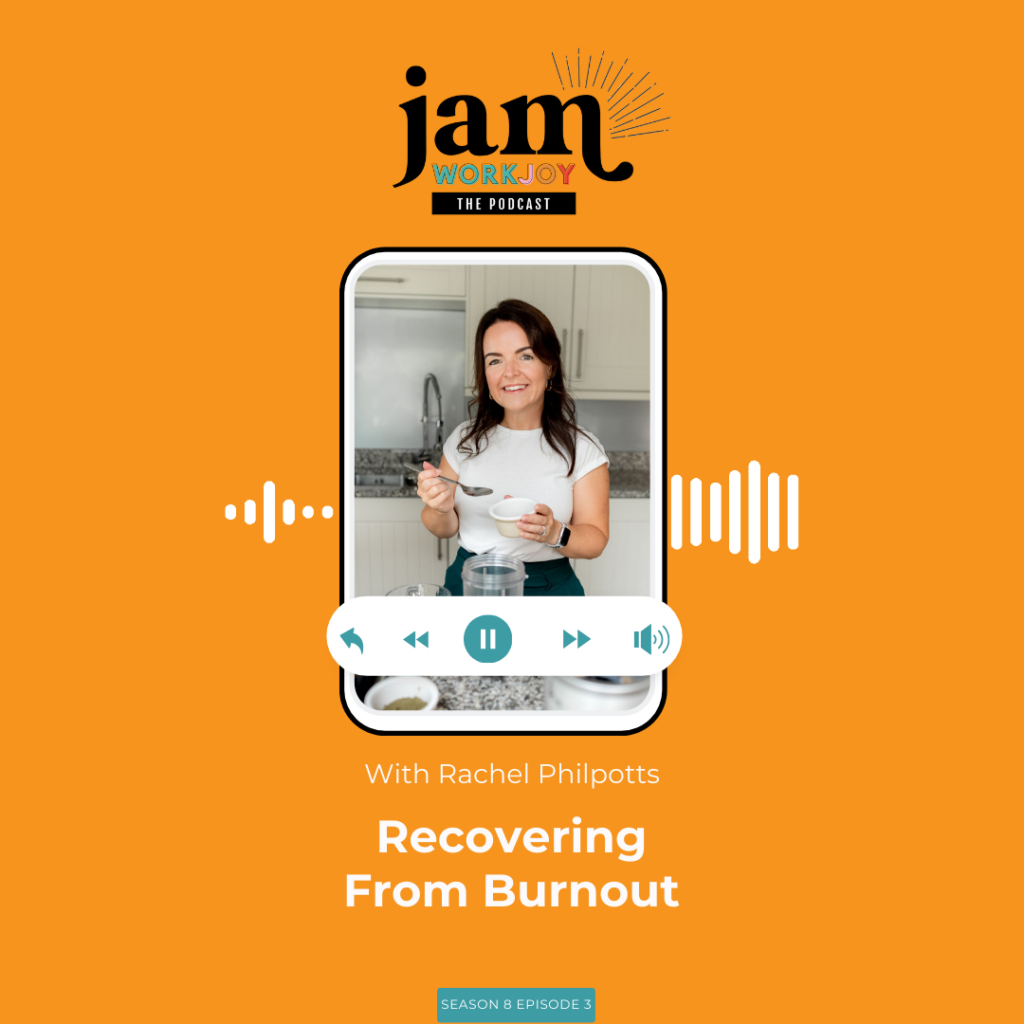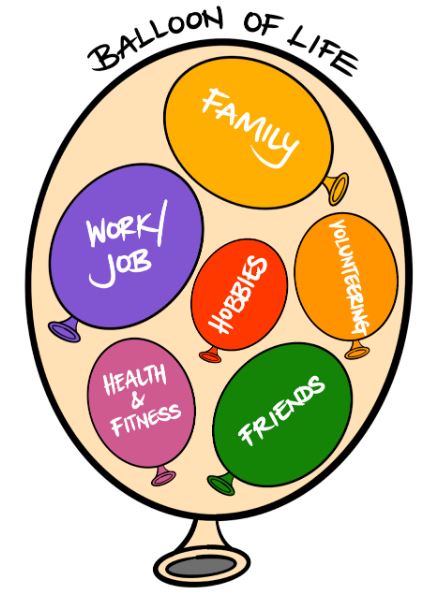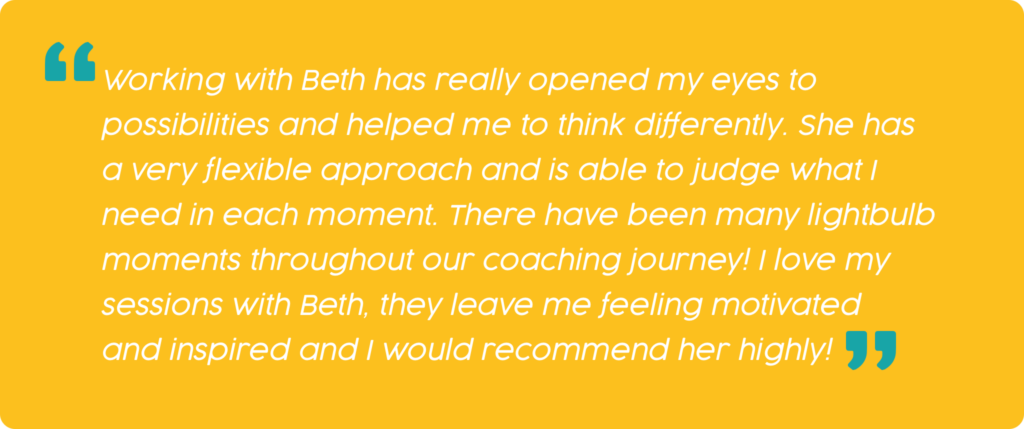THE BLOG
Get rid of work-life balance
You’ve been chasing work-life balance for who knows how long, but as soon as you seem to get close, it slips through your fingers again…
You’ve been gunning it for so long, you’ve got nothing left. You don’t eat well, sleep well, you’re always ill and you can’t muster the enthusiasm for anything…
You played your heart out as a kid and it lit you up but somewhere amongst all the working and adulting, you’ve lost sight of the things you love…
Work-life balance – have you ever had it? What about you? Nope. Me either. I feel pretty privileged in the work department, in that my ‘department’ is pretty much me and my awesome team, and I do work that brings me WorkJoy on a regular basis, but I have weeks – sometimes months – where work totally takes over. And I have periods where life takes over, too, and I have to book a rental in the middle of nowhere and go walk my dog for a week. It’s not because I’m doing anything wrong. It’s because that’s how it goes. This whole work-life balance thing is a scam! It ebbs and it flows and, and it’s our jobs to ride the waves and look after ourselves while we do it. 🌊 But sometimes it all gets too much and we have to work hard to avoid burnout, or even harder to recover from it. That’s the subject of today’s guide. Climb aboard and let’s cast off!

I’m Beth Stallwood – coach, consultant, speaker, podcast host, author and creator of all things WorkJoy. In this guide, we discuss why work-life balance is BS, talk a lot about balloons (trust me!) and I share some lesser-known ways to recover from burnout.
How to use this guide
This guide is a tale of two Bs, really. The first is about balance (and balloons – you’ll see). If you’re struggling with your work-life balance (and honestly, why wouldn’t you be), start at the beginning. But if you feel like you’re slowly slipping into that other big ‘B’ – burnout – or you’re already in it and wondering how to get out, you can always skip to half way.
Contents
Let’s call BS on work-life balance
The life balloon exercise
Why fixing work-life balance won’t fix your burnout
What is your burnout telling you?
How to: recover from burnout, the WorkJoy way
15 little ways to look after yourself
WorkJoy community story: Time for living
Next steps: Choose a balloon to fill
Let’s call BS on work-life balance
The notion of work-life balance has been talked about for decades now, as has the idea that if you achieve it, everything will be perfect. Most of us haven’t managed to find this utopia. Many people struggling with WorkGloom feel more like a circus performer, juggling with different-sized and weighted objects with sharp corners, while riding a unicycle, than they do a calm and collected master balancer.
The very idea of work-life balance makes lots of assumptions. Let’s challenge the term, unpick it and, perhaps, find a more realistic way of thinking about how work fits into your life:
- It puts work first in the sentence and there’s something powerful about the ordering. Work is an important part of life, yet does it really come first out of everything?
- The phrase ignores the fact that you are still alive when you’re working. Your life doesn’t stop and start at the office door or Zoom screen. There is much life to be had at work – just think of the experiences, friends, and sense of purpose it gives you.
- It also assumes that things stay static – that the size of work stays the same and that your life outside of work does too. Well, anyone who’s worked while having a life will tell you that there are times when this simply isn’t true:
- Sometimes life outside of work takes over. Things like building a family, caring for others, having a hobby, or moving house simply fill up all the space (and then some!).
- Sometimes work takes over. Things like big projects, working towards a qualification, or putting all your effort into achieving a promotion take up bucket loads of time and energy.
The energy you invest trying to find this balance is like trying to find the needle in the haystack of life. It’s impossible, and because of this, you feel you’ve failed, and the self-pity party really gets going. That’s not to say that balance isn’t a good thing – having anything out of kilter can have a serious impact on your ability to maintain joy. Let’s just make sure you’re balancing things in a way that makes sense for the real world. Instead of the see-saw of balance, being weighed down at one end or the other, how about we create a more realistic version of what work looks like in the context of life?
If you’ve found yourself teetering on the edge of, or fully emersed in the quagmire of burnout, let me point you in the direction of expert Rachel Phillpotts, author of The Burnout Bible. We chatted all about this topic in one of the WorkJoy Jam episodes.

“The common denominator is definitely stress. And stress has such a far wide reaching impact on our body and the way that we are able to function. But that then links in with lots of other things that are going on behind the scenes that could be causing burnout at a physical level. So, for example, we might see imbalances in brain chemistry that help us to focus or help us to feel happy or joy or help us to feel motivated so they can become out of balance as a result of stress.“
Check out the full episode here.
The life balloon exercise
Visualise for a moment a massive transparent balloon (one of those fancy ones from a party shop), that can have other balloons blown up inside it. The transparent balloon is representative of your whole life. Each inner balloon represents a feature of your life that is important to you. One might be friends, another family, one is likely to be work (the paid kind), another could be some of the unpaid work you do, and perhaps you have a few for your favourite hobbies?

| Reflection question: Take a few moments to think about which balloons feature in your life and note them down. |
The balloons you create in your life will be unique to you. The size of each inner balloon can expand and contract based on the choices you make about how much time and energy you will dedicate to them. Your balloons may also have inner balloons inside of them (for example your work balloon may have your role, the projects you work on, your team, etc. as part of it).
Sometimes, one balloon may need to be larger than all the others, because life throws a variety of wonderful and scary and heart-breaking things at you. That may mean that other balloons need to deflate a little for a while. They’re still there, ready and waiting for when you have the space to breathe life into them. You may find that you have too many balloons or some balloons demanding the energy you’d rather invest elsewhere.
The inner balloons are either controllable or at least influenceable (based on your choices). Your outer balloon is fixed by the annoying limitation of time available. You might find that the more you look after the inner balloons, the more the outer balloon feels like it’s a little bit more flexible. There are some balloons that act as incredible energy suppliers, giving back to you when you invest in them. These are joyful balloons – keep them, nourish them, love them. Get to know why these balloons give you the joy and consider how you can maximise the impact:
| Reflection questions: Why does this bring you joy? How can you expand the time and energy you give to this? What can you learn from this that you could repeat or transfer to another balloon? |
You may find that some balloons have been handed to you by someone else. Or some may guzzle up your energy but never offer anything in return. Take some time to analyse these:
| Reflection questions: Why does this bring you gloom? How could you rearrange how much space this balloon takes up in your life? What would popping this balloon and removing it from your life mean? |
The challenge is to allow the balloons to be the right size more often and not allow the single balloon of work to take over all the time.
| FREE DOWNLOAD Once you’ve figured out your balloons, download my Balloon Sorting template to help you decide where to focus your energy. Get it here. |
Why fixing work-life balance won’t fix burnout
Almost as important as the balloons themselves is the space between the balloons. Having 27 fully filled balloons trying to squeeze every breath out of you and filling every second leaves no room for anything else. If your balloons are rubbing up against each other, they’re going to create that static that makes your hair stand on end. They will have you headed towards burnout quicker than you can deflate them.
Burnout is a state of physical, mental, emotional and even spiritual exhaustion. In the depths of burnout, it can feel impossible to raise the enthusiasm required for even the simplest of work or life tasks, or even, and heartbreakingly, the things that really used to light you up. While an over-filled balloon will definitely have contributed to your burnout, recovery from it isn’t as simple as popping your way through them, until there’s nothing left but work and bubble baths.
Sure, you could wipe your schedule clean of everything but the essentials, but understand that your burnout happened slowly, over a period of months or even years – and you will need to commit time and effort to the process of moving on from it. Sorry, but there is simply no ‘quick fix’.
What is your burnout telling you?
Recovering from burnout will likely require a holistic approach. By that I don’t mean spending a fortune on alternative therapies (although some can be helpful). I mean, it requires looking at the ‘whole’ picture of your burnout. As a start, read each of these statements in turn, and keep a score of how many apply to you right before you burned out.
| The burnout checklist ☑ I didn’t make or defend my boundaries at work ☑ I experienced an unusual amount of stress or anxiety in my work or personal life ☑ I over-committed myself to family or social obligations ☑ I was caring for others over and above myself ☑ I stopped doing things that keep me fit, healthy and happy ☑ I found screen time taking over, but couldn’t seem to stop ☑ I didn’t ask for support when I should have ☑ I didn’t act on signs that I was burning out, e.g., poor sleep, high anxiety or frequent illness |
Burnout is effectively your body and mind yelling, ‘STOP!’ at you. In fact, it’s probably been yellings for a while, but you didn’t hear it because you were very, very busy and very, very stressed. Much has been written about how to recover from it (yes, you will need to prioritise rest, good nutrition and gentle exercise, yes, you will need to pare back your social calendar and yes, you will need to put some firm boundaries in place at work and learn to say ‘no’) so I’m going to focus on just three more below-the-radar factors:
- Acceptance
- Patience
- Joy
How to: recover from burnout, the WorkJoy way
1. ‘Acceptance.’ ‘Surrender.’ Call it what you will, but the first step to recovering from burnout is to admit to yourself that you are, in fact, burned out. Denial will get you nowhere, expect deeper into burnout and eventually, probably very sick indeed. Realising that you are not Superwoman but simply human, like the rest of us, is humbling and also quietly liberating.
– If you’re not Superwoman, you don’t have to save everyone, all of the time
– If you’re not Superwoman, you can afford to walk away from stress and drama
– If you’re not Superwoman, you’re going to have to look after that gorgeous body, aren’t you?
2. Like I said, there’s no quick fix here. Recovering from burnout will take as long as it takes and goals won’t help. Instead of focusing on what you’re missing and sacrificing, focus on what you and your body needs. Give yourself the time you need now and you’ll be stronger and wiser on the other side.
3. One of the first things to slide when we’re approaching burnout seems to be anything that brings us joy. Unconsciously, we see these things as trivial and much less important than, say, work deadlines or caring responsibilities. But my theory is that it’s precisely in cutting ourselves off from our joy, that we hasten our descent into burnout. So adding joy back in – at least a little, every day – is an essential step on the road to recovery. In other words…
Go away and have some fun
Have you ever watched a child playing? It’s a serious business. Kids prioritise their play and do it daily. They defend their toys and the things that bring them joy fiercely. Take away their play and the psychological impact is huge. Yet, as adults, most of us have forgotten how to play, and we’ve certainly lost the ability to prioritise it.
Let’s be clear, I’m not advising you to buy a colouring book or crack out your nephew’s lego (unless that’s your thing, in which case – cool), but to reconnect with what ‘play’ looks like for you. I tinkle on the piano and make my dog howl. Perhaps you sew, or do crosswords, or grow things, or bake things or spend time with animals or tootle about in nature.
The point is: do it.
| Reflection questions: How do you play? What would playing daily bring to your life? When can you schedule your play? |
15 little ways to look after yourself
When you’re on the way back from burnout (well done and welcome back!) it can be helpful to schedule in little pockets of time to replenish your energy each day and stop you sliding back into pure DOING. Try these things and add your own:
Get yourself outside
• Go for a 10-minute walk around the block/your workplace
• Have your morning coffee/tea outside and watch the world go by
• Do a walk-and-talk meeting (in person or on the phone)
Take brain breaks
• Reclaim your lunch break away from your desk/workspace
• Listen to a podcast/watch a TED talk/read a chapter of a book
• Complete a guided meditation or mindfulness session
Move your body
• Put on your favourite tune and take a three- minute dance break
• Take part in an activity that makes you smile (or try out some new ones)
• Stand up from your desk (if you work at one) at least once an hour
Nourish your body
• Drink water – by the time you’re thirsty you’re already dehydrated
• Eat food (who hasn’t skipped lunch to meet a deadline?)
• Eat carbs – your brain needs them to function (not just biscuits though – I checked)
Sleep
• Have a screen time curfew before bed
• Go to bed earlier
• Take a nap if you’re tired
And one final one for good measure – plan in and take all of the annual leave/paid time off you are offered.
WorkJoy community story: Time for living
| “I’d moved to London for my job and was working 14-hour days. I didn’t have the time or the energy after work to find myself a group of friends who lived locally, so I started to feel isolated. My life and work were so out of balance and I identified that what I wanted to work on was building a social life outside of work. It turned out to be a really important step as I left my job shortly after the move. “The WorkJoy toolkit helped me to weigh up whether work/life balance actually exists and prompted me to explore what I wanted to do with my free time. I’d started working from home and saw how important it was to get out during the day. I also set aside time to exercise and switch off from my screen. I started reading books again! The irony is that I now get so much joy from my work that I don’t mind working in the evenings. “The big lesson for me is that things will shift. It’s not always an equal amount of work and life and that’s okay. What’s important is that now I know when I need to get my balance back and how to do that.” |
Next steps: Choose a balloon to fill
In the name of progress over perfection, let’s commit to doing one thing to getting unstuck or moving forward (remember: in any direction). It could be booking a chat with someone in your squad, researching a course, role or organisation, or even doing a guided meditation. Or you could commit to one of these things:
Reading a chapter a week
If that book happened to be my book, WorkJoy: a toolkit for a better working life, you’d have absorbed an entire WorkJoy curriculum in three months.
Listening to a podcast on your commute
My WorkJoy Jam podcast archive is full of guests chatting about goals, motivation, limiting beliefs, habits and more. Think of it like absorbing WorkJoy by osmosis.
Listening to a five-minute audio every day
My 21-day GloomBusters audio guide pops into your WhatsApp every day for three weeks. There’s no better route out of WorkGloom.
Booking a 1-1 coaching call with me
Simply the best way to get unstuck, pronto. You can schedule it right now.
You can also follow me on Linkedin and Instagram for an (almost) daily dose of WorkJoy.

Spread the WorkJoy
Know someone who’s on the cusp of burnout? Pop this guide into their inbox…and maybe plan a little funsies for you both.
CATEGORY
10/04/2024